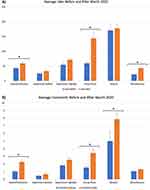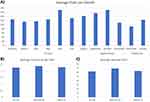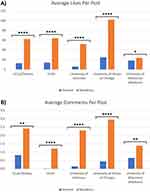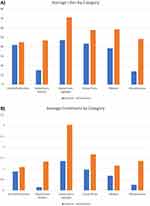Back to Journals » Clinical Ophthalmology » Volume 17
Utilization of Instagram by Ophthalmology Residency Programs in the Era of COVID-19
Authors Qin VL, Chen AY, Bashir H, Hsu D , Wushanley L, Lee V
Received 18 November 2022
Accepted for publication 12 April 2023
Published 5 June 2023 Volume 2023:17 Pages 1575—1585
DOI https://doi.org/10.2147/OPTH.S398170
Checked for plagiarism Yes
Review by Single anonymous peer review
Peer reviewer comments 2
Editor who approved publication: Dr Scott Fraser
Vivian L Qin,1,* Amy Yimin Chen,2,* Hasan Bashir,3 David Hsu,4 Lily Wushanley,3 Vivian Lee1
1University of Pennsylvania, Scheie Eye Institute, Philadelphia, PA, USA; 2University of Pennsylvania, Vagelos Program in Life Sciences & Management, Philadelphia, PA, USA; 3Rutgers University, Robert Wood Johnson Medical School, New Brunswick, NJ, USA; 4University of Pennsylvania, Perelman School of Medicine, Philadelphia, PA, USA
*These authors contributed equally to this work
Correspondence: Vivian Lee, University of Pennsylvania, 51N 39th Street, Philadelphia, PA, 19104, USA, Tel +1 215-662-8125, Email [email protected]
Purpose: The aim of this research is to describe the use of the social media platform, Instagram, by academic ophthalmology residency programs in the United States over time and consider the impact of the COVID-19 pandemic on ophthalmology’s social media presence.
Methods and Subjects: This cross-sectional study was conducted online by reviewing the publicly accessible Instagram accounts of all accredited US academic ophthalmology residency programs.
Main Outcomes and Measures: Number of US ophthalmology residency programs with an affiliated Instagram account were analyzed by year of creation. The content of the top six accounts with the most followers was analyzed by evaluating amount of engagement within defined post categories.
Results: Of the 124 ophthalmology residency programs, 78 (62.9%) were identified as having an affiliated Instagram account, 60 accounts (48.4%) were created during the years 2020 or 2021, and 62 (50.0%) accounts focused specifically on promoting the residency training program. Of the top six accounts with the most followers, post categories that received the most engagement were “Medical” and “Group Photo”, while those that received the least engagement were “Department Bulletin” and “Miscellaneous.” User engagement on posts as measured by likes and comments increased across multiple post categories after January 2020.
Conclusion: Social media presence of ophthalmology residency programs on Instagram increased substantially in 2020 and 2021. As a result of the COVID-19 pandemic restricting in-person interactions, residency programs have used alternative platforms to reach applicants. Given the increasing use of such applications, social media will likely continue to become an important aspect of professional engagement in ophthalmology.
Keywords: social media, medical education, ophthalmology, ophthalmology residency
Introduction
Social media has imbedded itself in medicine as a formidable means of worldwide communication. Within ophthalmology, professional organizations, journals, and advocacy groups engage with audiences on platforms such as Facebook, Twitter, and Instagram for educational and promotional purposes.1 Clinicians and researchers also use these platforms to circulate data/publications and enhance collaborations/conference engagement.2,3 Less frequent but notable uses also include difficult case deliberations and responses to patient-initiated queries.4
A workshop presented at the 2009 Association of Program Directors in Surgery identified the importance of the Internet and social media in recruiting applicants to residency programs.5 Since then, a 2017 systematic review of social media in graduate medical education (GME) found that residency programs have been leveraging social media platforms as a tool for education and learner engagement, as well as a means of increasing visibility in resident recruitment.6 Moreover, a survey of 208 surgery faculty and GME trainees showed that 70% positively viewed social media in the context of professional development, and 22% preferred to use social media for communication and networking.7
The COVID-19 pandemic has underscored the role of social media as a communication tool that bypasses in-person interactions. Ophthalmologists and organizations have turned to online channels to share clinical strategies to enhance provider and patient safety while maintaining continuity of care. Researchers have continued collaborations through these platforms, producing record rates of publications.8
The pandemic has required academic departments to adapt their residency application process, such as incorporating social media.6 Without traditional in-person activities, programs have relied on virtual mediums to provide interactive opportunities for applicants while showcasing their programs. A study across all residency programs found that 57% of programs had a social media presence, of which 33% of accounts were created after March 2020 and 58% were specifically associated with the residency program.9 In this analysis, we assess specifically how ophthalmology residency programs have responded to pandemic restrictions through Instagram, a major social media outlet with a prominent presence in the medical field.10–14
Materials and Methods
As of November 12, 2021, 124 accredited ophthalmology residency programs were identified using the Accreditation Council for Graduate Medical Education (ACGME) database. Seventy-eight programs were identified as having an Instagram account using search engines for “[residency program name]” + “Instagram” and/or referencing each program’s website.
For each account, the following data were collected: number of posts, followers, and followed accounts; for the chronological first and most popular posts: date of post, content, number of likes, and comments. Figure 1 shows a representative image of an Instagram account profile page from which information could be retrieved. The most popular post, determined by number of likes, was classified into one of six content categories: Award/Publication, Department Bulletin, Department Highlight, Group Photo, Medical, or Miscellaneous, which are listed in Table 1 with examples in each category. For the top six accounts, as determined by number of followers, each post after January 2018 was classified into these six categories and the number of likes and comments was calculated. To account for the increase in number of accounts and activity due to COVID-19, data were separately analyzed for posts before and after March 2020, which is when the World Health Organization (WHO) declared COVID-19 a pandemic and the USA restricted all travel. A two-tailed independent t-test was utilized to determine a statistically significant (α = 0.05) change in engagement before and after March 2020.
 |
Table 1 Instagram Post Categories and Examples |
 |
Figure 1 Features and layout of a typical Instagram account profile page. Reproduced with permission from the account holder. |
A Python script was created to assist in data collection by recording number of likes and comments for each post using the Python Library Instascrape and Selenium WebDriver (Supplementary File 1). Because this study did not include identifiable individual information, Institutional Review Board approval from the University of Pennsylvania Human Subjects Electronic Research Application was not required.
Results
Of the 124 ACGME-accredited ophthalmology residency programs, 78 programs (62.9%) had an Instagram account. Of these, 52 (66.7%) had accounts dedicated to the residency program, 16 (20.5%) had accounts for department-wide news plus residency training, and 10 (12.8%) had both. Prior to 2019, only 5.6% of programs participated on Instagram, jumping to 50% in 2020 then 62.9% in 2021 (Table 2). The number of ophthalmology program Instagram accounts increased by 1014.3% from 2018 to 2021 (Figure 2), far surpassing the 100% growth in monthly active users (MAU) for Instagram over the same time frame.15 The fastest growth in number of new accounts occurred in the third quarter of 2020 with the creation of 28 new accounts (Figure 2).
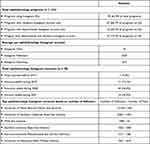 |
Table 2 Characteristics of Ophthalmology Residency Programs Using Instagram |
Characteristics of ophthalmology departments using Instagram are detailed in Table 2. The top five ophthalmology accounts based on number of followers are as follows: University of Miami Bascom Palmer Eye Institute, University of Southern California Roski Eye Institute, Wills Eye Institute, Stanford University Byers Eye Institute, and Harvard University Massachusetts Eye and Ear Infirmary. The sixth most popular account was University of Oklahoma Dean McGee Institute, which had only 10 fewer followers than Harvard University's Massachusetts Eye and Ear Infirmary at the time of data collection. Given the minor difference between the top fifth and sixth accounts, information on the top six accounts is presented in Table 2. For the 78 programs on Instagram, the most popular posts as determined by number of likes fell into three categories: “Department Highlight” (74%), “Medical” (21%), and “Award/Publication” (5%). The most common type of “Department Highlight” posts involved match lists, graduation photos, and resident spotlights. Of the top six ophthalmology accounts, the most common post was Miscellaneous (38%), while Medical had the highest engagement with an average of 176 likes and 7 comments.
When comparing posts before and after March 2020, the following categories increased in relation to total posts: Award/Publication (18% to 25%), Department Highlight (5% to 12%), and Medical (7% to 17%); while the following decreased: Department Bulletin (16% to 9%), Group Photo (12% to 6%), and Miscellaneous (42% to 31%). Regarding engagement, there was a statistically significant increase in the number of likes for Award/Publication, Group Photo, and Miscellaneous; and a statistically significant increase in the number of comments for Award/Publication, Group Photo, and Medical (Figure 3).
Both account activity and follower engagement were consistent throughout the residency application cycle, which were divided by months (ie “pre-application” months of February–August, “application/interview” months of September to November, and “making rank list” months of December to January). In addition, the average number of posts per month created by accounts did not significantly differ by time point in the residency application cycle (Figure 4). Finally, the average number of comments per post and likes per post also did not differ significantly between these three time ranges.
Ten programs (Wills Eye Hospital, Massachusetts Eye and Ear, Duke, University of Illinois at Chicago, UCSD, UCLA/Doheny, Baylor/Cullen, University of Arkansas, University of Michigan, University of Wisconsin (Madison)) had two active Instagram accounts, one residency-specific account and one general department account. The average number of followers for the general department accounts was 1680, while the average number of followers for residency-specific accounts was 1332. While the residency-specific accounts had a lower number of overall followers, the amount of user engagement was higher on these accounts than on the corresponding department-wide accounts (Table 3). All 10 residency-specific accounts had a higher number of average comments per posts and/or a higher number of average likes per post. Five residency-specific accounts (UCLA/Doheny, UCSD, University of Arkansas, University of Illinois at Chicago, and University of Wisconsin) had both a higher number of average comments per posts and average likes per post (Figure 5). This trend held even when the types of posts were broken down by category of post (Figure 6).
 |
Table 3 Average Likes and Comments per Post of Ophthalmology Programs with Both Residency-Specific and General Department Accounts |
Discussion
Social media in medicine is expanding and is increasingly recognized as an influential and useful tool. Our study shows the growing utilization of Instagram, a popular social media platform, by US academic ophthalmology departments. More than half have Instagram accounts, with the majority focused solely on the residency program, while 10 programs have residency-specific accounts in addition to general department accounts. Instagram has become an increasingly prominent way for programs to share highlights, ranging from events to resident narratives.
The average number of followers per account in our study is 1029. This represents a dramatic increase from a 2018 study that reported only 5% of these departments had Instagram accounts with an average of 113 followers.16 This trend can partially be attributed to the rising popularity of social media, especially Instagram among young adults. While the 2021 Pew Research Center survey showed only a modest increase of 5% of US adults using Instagram from 2019 to 2021,17 71% of adults aged 18–29 and 49% of college graduates reported using Instagram. Given that most residency applicants belong to this age and education demographic, Instagram is well-poised to reach programs’ target audiences.
Another likely factor for the rapid growth is the COVID-19 pandemic. The WHO declared COVID-19 a pandemic on March 11, 2020.18 To adapt to public health restrictions, SF Match and the Association of University Professors of Ophthalmology discouraged in-person away rotations and recommended virtual interviews.19 Residency programs, therefore, had to explore alternative ways to communicate with and recruit applicants, which included social media platforms. This is reflected by the fact that 60 (76.9%) ophthalmology Instagram accounts were created between 2020 and 2021, and that 28 (36%) were created in the months of July–September 2020, which was when SF Match applications opened after the COVID-19 pandemic was declared. Similar trends have been reported in other specialties as well.20–24
The pandemic jumpstarted an exploration of new ways to interconnect without in-person contact, including ways ophthalmology residency programs disseminate information and solicit interest. Three content categories of posts received significantly more “likes”, and all but one category received significantly more comments when comparing engagement before and after January 2020, suggesting Instagram has been a successful method for programs to engage with applicants. Furthermore, when specifically comparing programs with both an active residency-specific Instagram account and a department-wide Instagram account, the residency-specific account had higher user engagement, as determined by average number of likes and comments per post. Higher engagement was seen across all the categories in this study, despite having a lower overall number of followers than department-wide accounts. This may suggest that audiences of residency-specific accounts are more engaged with this type of social media content and that these accounts are having their desired effect of reaching and engaging their audiences. This data may be useful for social media account managers to better engage their audiences.
The most popular category of posts overall was the “Department Highlight”, in which achievements of individuals and the overall residency program was showcased, such as Match results and graduation celebrations. This aligns with previously published data showing that promotion of the residency program and community’s accomplishments generated the greatest follower engagement, more so than promotion of education.10 One possible explanation for this finding could be that followers of ophthalmology residency program's Instagram accounts are most interested in using Instagram to understand the culture and life of the program. A 2021 study of 64 otolaryngology (ENT) residency applicants found that 85% of applicants reported social media accounts were most helpful in showcasing program culture, while less than 25% reported accounts were useful for education on ENT topics.25 Further research, such as characterization and surveys of users, would be beneficial to elucidate ophthalmology program follower preferences and behavior.
The categories of “Group Photo” and “Award/Publication” both showed a statistically significant increase in engagement via both likes and comments when comparing the time period before and after March 2020. One possible explanation could be that these categories are more likely to include posts identifying specific individuals, and as the number of followers increased over the same time period, more followers may recognize the featured individuals, and thus engage with the content. Further research into follower behavior is necessary to definitively explain the rationale for this increase.
Given the retrospective nature of this study, there are several limitations. Our results only reflect a finite period of time, and new program accounts could have been added after our data collection timeframe. While we categorized posts based on general content category, these categories are not validated nor standardized. In addition, the impact of social media in ophthalmology may be underestimated in this study since a single social media platform was evaluated. Further research should investigate the use of other platforms by ophthalmology residency programs. Our study also only analyzed Instagram posts, excluding time-limited content such as “Instagram stories” that are available for 24 hours and have additional customization through interactive polls and countdowns. Analysis of “Instagram stories” could help investigate other aspects of engagement such as the number of followers who may be viewing content without liking or commenting. Furthermore, additional research using tools such as surveys of ophthalmology programs and their Instagram followers can provide more direct insight into motivations behind account content as well as follower engagement. Nevertheless, our data suggest an increasing presence of ophthalmology on social media with an audience that is increasingly engaging with content.
Conclusion
Social media has become an important facet of medical engagement and will likely continue to grow in the future. Our study found that the majority of ophthalmology programs have a social media presence on the Instagram platform. 76.9% of the accounts were created in 2020, which correlates with the timing of the COVID-19 pandemic and reflects the increasing social media presence of residency programs in other specialties as well.
Instagram follower engagement, as defined by likes and comments on programs’ posts, increased in the same time frame as the increase in the number of residency program accounts. Engagement was particularly pronounced in the categories of posts that showcased the accomplishments and the culture of the program, which may indicate the content types followers are seeking out.
When comparing follower engagement between residency-specific versus department accounts of programs that had both types of Instagram accounts, the residency-specific accounts acquired more average likes and comments per post. This could suggest that followers are more likely to engage with content that specifically focuses on GME and training, potentially reflecting the demographic and training level of the Instagram users.
Further research efforts should be made to measure the impact of Instagram and social media on the residency application and match process to inform the management of this powerful tool.
Acknowledgments
We thank Albert Chen for his expertise and assistance with the Python script.
Disclosure
Dr. Vivian Lee reports grants from NIH, endowment that supports research from Yanoff Endowment Fund, during the conduct of the study; personal fees from GSK, outside the submitted work. The authors report no other conflicts of interest in this work.
References
1. Micieli JA, Tsui E. Ophthalmology on social networking sites: an observational study of Facebook, Twitter, and LinkedIn. Clin Ophthalmol. 2015;9:285–290. doi:10.2147/OPTH.S79032
2. Tsui E, Rao RC. Navigating social media in #ophthalmology. Ophthalmology. 2019;126(6):779–782. doi:10.1016/j.ophtha.2019.02.015
3. Christiansen SM, Oetting TA, Herz NL, et al. Twitter at the 2014 and 2015 annual meetings of the American Academy of Ophthalmology. Ophthalmology. 2016;123(8):1835–1837. doi:10.1016/j.ophtha.2016.03.012
4. Mahjoub H, Prabhu AV, Sikder S. What are ophthalmology patients asking online? An analysis of the eye triage subreddit. Clin Ophthalmol. 2020;14:3575–3582. doi:10.2147/OPTH.S279607
5. Schlitzkus LL, Schenarts KD, Schenarts PJ. Is your residency program ready for generation Y? J Surg Educ. 2010;67(2):108–111. doi:10.1016/j.jsurg.2010.03.004
6. Sterling M, Leung P, Wright D, Bishop TF. The use of social media in graduate medical education: a systematic review. Acad Med. 2017;92(7):1043–1056. doi:10.1097/ACM.0000000000001617
7. Wagner JP, Cochran AL, Jones C, Gusani NJ, Varghese TK, Attai DJ. Professional use of social media among surgeons: results of a multi-institutional study. J Surg Educ. 2018;75(3):804–810. doi:10.1016/j.jsurg.2017.09.008
8. Tsui E, Rao RC, Carey AR, Feng MT, Provencher LM. Using social media to disseminate ophthalmic information during the #COVID19 pandemic. Ophthalmology. 2020;127(9):e75–e78. doi:10.1016/j.ophtha.2020.05.048
9. Singh NP, DeAtkine AB, Hattaway RH, Chisolm PF, Rais-Bahrami S, King TW. Changes in United States residency program online presence following COVID-19. Teach Learn Med. 2022;1–11. doi:10.1080/10401334.2022.2047050
10. Haskins IN, Sillcox R, Ganguli S, et al. The evolving role of Instagram in general surgery residency programs and keys to successful use in yours: input from an academic, tertiary referral program. J Surg Educ. 2021;78(6):2078–2087. doi:10.1016/J.JSURG.2021.04.009
11. Li TM, Tepper DL, Burger A, Weissman MA. “Insta residency:” characteristics of engagement with an internal medicine residency program Instagram account. Cureus. 2022;14(3). doi:10.7759/CUREUS.23565
12. Clay Pruett J, Deneen K, Turner H, et al. Social media changes in pediatric residency programs during COVID-19 pandemic. Acad Pediatr. 2021;21(7):1104–1107. doi:10.1016/J.ACAP.2021.06.004
13. Harp T, Szeto MD, Presley CL, et al. Usage and engagement with Instagram by dermatology residency programs during the COVID-19 pandemic compared with Twitter and Facebook. J Am Acad Dermatol. 2021;85(5):e313–e315. doi:10.1016/J.JAAD.2021.05.071
14. Moore MG, Kinzer A, Barhorst K, Singerman K, Dembinski D, Gobble R. Communication: virtual application cycle impact on integrated plastic surgery residency Instagram presence. J Plast Reconstr Aesthetic Surg. 2022;75(8):2831–2870. doi:10.1016/J.BJPS.2022.06.012
15. Rodriguez S. Instagram surpasses 2 billion monthly users. CNBC; 2021. https://www.cnbc.com/2021/12/14/instagram-surpasses-2-billion-monthly-users.html.
16. Melendez RF, Angadi P, Sledz E, et al. Academic ophthalmology departments and their use of Facebook, Instagram and Twitter social media pages. Invest Ophthalmol Vis Sci. 2018;59(9):6172.
17. Pew Research Center. Social Media Fact Sheet. Pew Research Center; 2017.
18. WHO. WHO Director-General’s opening remarks at the media briefing on COVID-19-11 March 2020. https://www.who.int/director-general/speeches/detail/who-director-general-s-opening-remarks-at-The-media-briefing-on-covid-19---11-march-2020.
19. Quillen DA, Michael Siatkowski PR, Steven Feldon O, Rochester M. COVID-19 and the ophthalmology match. Ophthalmology. 2021;128(2):181–184. doi:10.1016/J.OPHTHA.2020.07.012
20. DeAtkine AB, Grayson JW, Singh NP, Nocera AP, Rais-Bahrami S, Greene BJ. #ENT: otolaryngology residency programs create social media platforms to connect with applicants during COVID-19 pandemic. Ear Nose Throat J. 2020;1–5. doi:10.1177/0145561320983205
21. Schwartzman G, Qureshi A, Friedman AJ. Utilization of Instagram by dermatology residency programs in the era of COVID-19. J Am Acad Dermatol. 2021;85(1):204–206. doi:10.1016/j.jaad.2021.03.078
22. Jones HM, Ankem A, Seroogy EA, et al. Impact of COVID-19 on radiology residency selection process: a survey of radiology residency programs in the US. Acad Radiol. 2022;29(5):779–785. doi:10.1016/j.acra.2021.12.033
23. Bernstein SA, Harmon TG, Cabañez K, Wei C, Gold JA. Utilization of Instagram by psychiatry residency programs in a virtual recruitment world. Acad Psychiatry. 2021;45(6):746–750. doi:10.1007/s40596-021-01548-2
24. Chisolm P, Singh N, Zaniewski R, Rais-Bahrami S, Rozzelle CJ. Neurosurgical residency adaptations for the residency application cycle amid the COVID-19 pandemic: acute on chronic sequelae. Interdiscip Neurosurg Adv Tech Case Manag. 2021;25:101177. doi:10.1016/j.inat.2021.101177
25. Patro A, Landeen KC, Stevens MN, Cass ND, Haynes DS. The digital dilemma: perspectives from otolaryngology residency applicants on social media. Ann Otol Rhinol Laryngol. 2022;131(9):954–961. doi:10.1177/00034894211050625
 © 2023 The Author(s). This work is published and licensed by Dove Medical Press Limited. The full terms of this license are available at https://www.dovepress.com/terms.php and incorporate the Creative Commons Attribution - Non Commercial (unported, v3.0) License.
By accessing the work you hereby accept the Terms. Non-commercial uses of the work are permitted without any further permission from Dove Medical Press Limited, provided the work is properly attributed. For permission for commercial use of this work, please see paragraphs 4.2 and 5 of our Terms.
© 2023 The Author(s). This work is published and licensed by Dove Medical Press Limited. The full terms of this license are available at https://www.dovepress.com/terms.php and incorporate the Creative Commons Attribution - Non Commercial (unported, v3.0) License.
By accessing the work you hereby accept the Terms. Non-commercial uses of the work are permitted without any further permission from Dove Medical Press Limited, provided the work is properly attributed. For permission for commercial use of this work, please see paragraphs 4.2 and 5 of our Terms.


